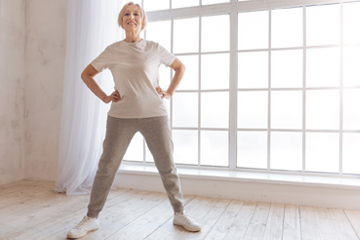People who have integrated walking as a regular exercise into their life could find it very challenging to walk outside when the weather is unfavorable or when there are other inconveniences. If you are forced to stay at home for some reason or other, the only solution is to take your walking program indoors. By doing so, you can continue to maintain a 30-minute moderate-intensity physical activity on most days without difficulty, burn those calories, and get fit.
Walking can help improve your overall health by increasing cardiovascular fitness; it also strengthens the bones, reduces excess body fat, and gives more power to the muscles. Without any equipment or any great effort, you can continue your walking exercise indoors.
Here are some tips you can follow for successful indoor walking:
- Walk around your house: Walk inside your home if you have got a big enough space. Try walking fast for 2 laps and then easier for 2 laps at least for 20 mins. Walk through your rooms, and you can switch directions if possible. Loop through around tables and furniture and do some stretching for the top part of your hip.
- Use the Stairs: Make it a habit to go up and down the stairs, it helps to
- reduce cardio risk by more than 30%
- build muscle tone
- burn more calories per minute than when jogging
- amp your core muscle strength
- Walk while you talk: Don’t forget to walk when you talk on phones. You can use a portable phone or a Bluetooth headset and walk around the house as you carry on conversations.
- Assign one particular exercise to each room and do each one as you walk from room to room, some examples are:
- Walk to the kitchen and do at least 10 squats against the counter.
- Walk to the living room and do 10 push-ups.
- Walk to the bedroom and do 10 crunches on the bed.
- Walk to the front door and do 10 jumping jacks.
- Walk around the house a few times and repeat the circuit.
Involve your arms to burn even more calories.
- Mall walking: If you feel bored walking inside your own home then there are plenty of ways to walk indoors outside of the home. You can call malls to enquire about mall walking and ask whether the shopping mall opens early or stays open late, for walkers. Avoid walking around food courts. If you have a choice of malls, pick one with wide halls so you can move briskly even when there are shoppers. You can also google “indoor walking tracks near me” to find places other than malls.
- Use a pedometer: Use a pedometer to keep track of how many steps you are taking daily. Increase the number of steps gradually.
Some things to consider before starting indoor walking:
- If you decide to start indoor walking, consult a doctor first to find out whether you are fit to perform indoor walking exercise. This is especially important if you have health issues, are a beginner, or a person that leads a sedentary life.
- Set your goals and be realistic. Once you start doing exercise you can scale your goal up and down accordingly.
- Maintain a proper posture by keeping your head up and eyes forward, and your spine should be aligned. Pump your arms a bit as you walk, let your arms pass by your body at about hip height. Follow toe-heel pattern when you walk.
- Monitor your walking and level up according to your ability.
- Take time to cool down as you approach the end of your walk; also, do some simple stretches.
Start your indoor walking exercise as soon as possible. Whether it’s good weather or bad weather, you can follow these tips to improve your health and lead a healthy and happy life.
Whether outdoors or indoors, walking is a great exercise that will benefit your body. Experts point out that walking is as beneficial as aerobic exercises. It helps boost your immune system, reduces the chances of diseases such as diabetes and cancer, and ensures a longer life than those who lead a sedentary or inactive life.
